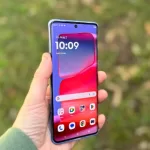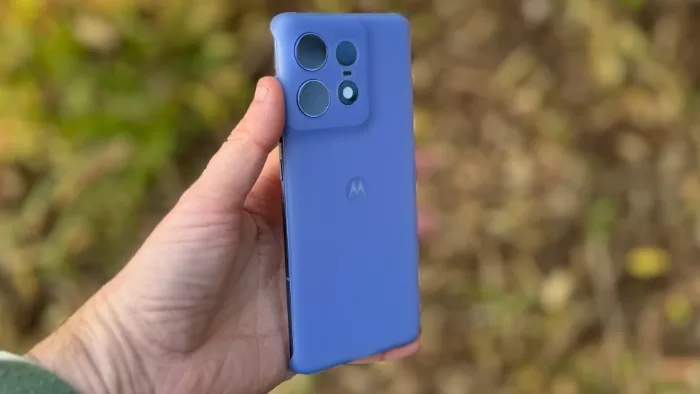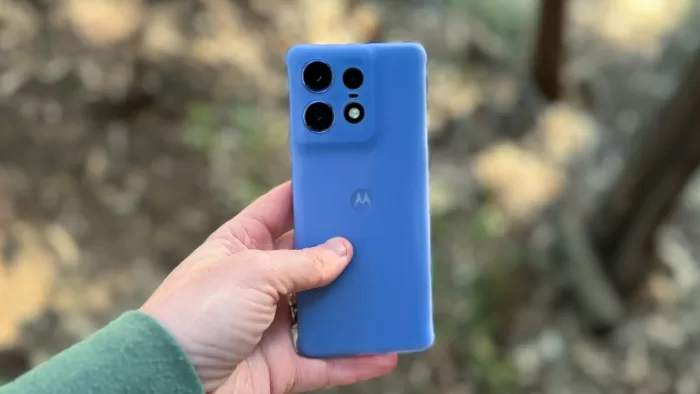
The Motorola Edge 50 Pro is competitively priced for a flagship, but it is let down by sub-par performance and ordinary battery life.
| Pros | Cons |
|---|---|
| Sleek physical design | Mid-range processor at a near-premium price |
| Insanely fast charger included | Comparatively middling battery performance |
| Triple lens camera | Camera post-processing is annoyingly slow |
Score: 2.5/5
 |
Buy The Motorola Edge 50 Pro! | Buy On Amazon |
In this review
Motorola Edge 50 Pro Specifications
Motorola Edge 50 Pro Design
Motorola Edge 50 Pro Camera
Motorola Edge 50 Pro Performance
Motorola Edge 50 Pro Battery
Motorola Edge 50 Pro Conclusion
The Motorola Edge 50 Pro isn’t Motorola’s most expensive handset – that would be the recently released Motorola Razr 50 Ultra – but at $999, it is effectively the company’s non-folding flagship phone.
That’s an interesting space for a flagship to occupy, well below the pricing you’d pay for Apple or Samsung’s premium phones.
However, it does throw the Motorola Edge 50 Pro into a very competitive space, where slightly older flagships and some high-end mid-range phones jostle for supremacy.
The design here is nice, the inclusion of triple lens cameras at this price point is a plus and it’s supplied with an insanely fast charger in the box… but it’s still seriously left me wanting more. Read on to find out why.
Also read:
Motorola Razr 50 UItra Review
Design

The Motorola Edge 50 Pro is built around a curved 6.7 inch 144Hz capable pOLED display. Curved displays aren’t to everyone’s tastes – I personally don’t mind them, but that’s very much a take-it-or-leave-it proposition to me, and your tastes may vary.
One interesting aspect of the display is that it’s Pantone validated for colour accuracy, though you do have to toggle it to the natural display setting for this to kick in. Otherwise you’ll be in vivid mode, where colours are extremely saturated.
It’s a nicely light phone in the hand at just 186g, and it’s great to see the inclusion of IP68-rated water resistance as well. For a long time, Motorola only advertised its phones as "water repellent", which basically meant that they weren't sponges...

You get three colour choices, with your choice of Black Beauty, Luxe Lavender (as tested) or Moonlight Pearl finishes. Moonlight Pearl is a specifically created polymer finish, but both Black Beauty and Luxe Lavender have (eugh) vegan leather casing.
I think I’ve made my feelings on vegan leather and its feel very well known by this stage; while I don’t think we should wrap phones in what used to be wrapped around perfectly functional bovines, there’s something “off” about the feeling of vegan leather that sets my skin crawling.
Thankfully Motorola provides a slender phone case in the box, and you’d better believe that thing flew onto the phone as soon as I started testing it.
The power button and volume controls sit on the right hand side, while the SIM card tray lurks at the base, next to the USB-C charging port. As with most flagship phones, there’s no dedicated 3.5mm headphone jack.
The Motorola Edge 50 Pro’s design is, to my eye quite nice; having spent a tiny amount of time with the Moonlight Pearl that’s the finish I’d go for if you really wanted a standout handset.
Camera

Motorola’s phone cameras have generally hit me as capable without being massively standout good.
At a technical level, the Motorola Edge 50 Pro should be the phone that changes my opinion, as it’s one of only a handful of sub-$1,000 phones to go the full triple, with wide, ultrawide and telephoto lenses to play with. Specifically that’s a 50MP wide, 13MP Ultra-Wide and 10MP 3x zoom telephoto lens, while selfies are handled at the front with a 50MP sensor.
In one sense it did, with the again-Pantone-validated cameras capturing generally pleasing shots in most conditions. I do appreciate having the flexibility of three lenses and zoom especially on a camera, because it gives you so much creative space to play in.
On the zoom front, it handles most shots well, though if you push beyond the stock 3x telephoto it does start to struggle a little. Push it all the way out to 30x zoom, and shots quickly fall apart, but that’s no different to any other extreme hybrid digital zoom.
Here's an example using a nearby shopping centre fountain as the centrepiece.

From the ultrawide lens, all is fine, even if it's a grim kind of day.

Wide is likewise fine, as you'd expect.

The next step up is 2x zoom, sitting between the wide and telephoto lenses.

3x zoom works fine, and even hides some of the lousy weather for me.

30x zoom is... not good. Nobody's extreme zoom ever is.
The biggest issue I had – and it’s one that I found really disappointing – was that it often takes a few seconds in post-processing between shots, and that’s time where additional shots were just plain lost.
There’s a reason for that (which I’ll get into in the performance section), but it all too often left me annoyed that a nice shot I should have been able to capture was missed because the Motorola Edge 50 Pro was still working on the last one.
This irked me especially as the output from the phone's cameras can be quite good for a phone at this price point -- but I was left waiting for it far too often and for too long between shots.
Motorola Edge 50 Pro Sample Photos






Performance

The Motorola Edge 50 Pro is Motorola’s current flagship non-foldable phone, so you’d expect something powerful to be lurking beneath its glass frame to give it flagship (or at this price, near flagship) performance, right?
Wrong.
It’s under the hood that Motorola’s kept the price down, but it’s done so by equipping it with a Snapdragon 7 Gen 3 processor. That’s a mid-range play, and while it’s nicely current in terms of processor history… it’s still a mid-range processor in a phone that’s just under flagship pricing.
Motorola matches up the Snapdragon 7 Gen 3 with 12GB of RAM and 256GB of fixed storage on board. All of this rather predictably leads to performance that’s not only mid-range, but also very quickly outclassed by what you can get on competing phones at this price point – or in some cases well below it.
To give that some context, here’s how it compares using Geekbench 6’s CPU benchmark.
When the Samsung Galaxy A55 – a phone that’s $300 cheaper – has a faster CPU, there’s an issue, I think.
The Edge 50 Pro does beat out the Razr 40 in this test, though if you tried to fold the Edge 50 Pro in half, you would break it.
It’s a little better on the graphics front, but not by much.
Mid-range phone processors are still decent performers in a day-to-day sense, but if I’m spending just shy of a grand on a phone and there’s competition out there that’s not just mildly but substantially better, why wouldn’t I buy it?
It really feels to me like Motorola’s made an odd call here; either the Edge 50 Pro has been robbed of the processor that it should have had, or it’s about $300 too expensive!
In software terms you're playing with Android 14, with Motorola promising three years of Android OS upgrades. That’s better than Motorola’s done in the past, but still below that of competitors such as Samsung or Google.
Motorola’s UI approach to Android has long been a lightweight one that’s appealed to me, but you do still get simple details such as chopping actions to activate the flashlight or twists to kick the cameras into gear.
You also get a smattering of included apps in the setup process, because <sarcasm alert> clearly every Android phone needs the Booking.com app on it to be complete, right?</sarcasm alert>
Also read:
Motorola Thinkphone review
Google Pixel 8a review
Battery

The Motorola Edge 50 Pro is a thin phone, and that does make it light in the hand… and in the battery capacity department too.
It is the very rare example of a non-folding Android phone that doesn’t include a 5,000 mAh battery pack within it. Instead, you get 4,500mAh of power to play with. As always, that’s a question not entirely of capacity, but how well a given phone actually handles its power.
To test that, first I turned to my comparative YouTube battery streaming test, pitting it against the same crop of similarly priced handsets to see how well it would hold up.
That really isn’t a great result for the Motorola Edge 50 Pro, comparatively speaking. Phones that get above 90% remaining in that test – and these days, that’s most phones – are typically good for a day’s battery usage, but every percentage point above 90% can equate to additional hours of usage time.
It’s not that the Motorola Edge 50 Pro is terrible in the battery life stakes, but it’s comparatively not good either. In day to day usage, I could get it through a day, as expected as long as my app usage wasn't too heavy. Again, that's true for every single phone.
One area where it does stand out is the inclusion of a very fast charger in the box, rated at 125W.
While it’s a GAN charger, it’s a solid brick of a thing by mobile charger standards, and not surprisingly it does the trick of topping up the Motorola Edge 50 Pro’s battery very well indeed.
On the wireless charging front, there’s support for up to 50W wireless charging, but this isn’t some weird Qi2 variant; you’d only get that with Motorola’s own specific 50W wireless charger, which I wasn’t able to test out for this review.
Motorola Edge 50 Pro: Alex’s Verdict

I’ve really liked a lot of Motorola’s recent phones, from the budget side of the equation all the way up to the Motorola Razr 50 Ultra.
The Motorola Edge 50 Pro sits in the middle of that equation, but it’s a hard one for me to recommend.
While it is nicely styled, and the cameras drop a lot of creative potential in your hands, the choice of processor means that this creative potential is all too often squandered. At this price it’s not hard to score a phone that will run faster than the Motorola Edge 50 Pro, and often for longer, too.
Was this review useful to you? Drop me a tip!
Motorola Edge 50 Pro: Pricing and availability
The Motorola Edge 50 Pro retails in Australia for $999.
 |
Buy The Motorola Edge 50 Pro! | Buy On Amazon |





